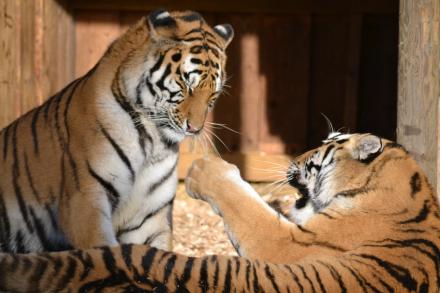Behavioural responses of Amur tigers (Panthera tigris altaica) and Bush dogs (Speothos venaticus) to olfactory enrichment
Johanna Sjöberg

Carnivore species heavily rely on their sense of smell for social communication and food search, but how sensitive are their noses to single odour components?
Animals which are prevented from performing their natural behaviours and also lives in insufficient environments sometimes develops abnormal and stereotypic behaviours. Carnivore species in captivity are particularly sensitive to insufficient environments and lack of external stimuli. One way to promote species-specific behaviour and lower frequecies of stereotypic behaviours is to provide he animals with environmental enrichment.
This study was made to investigate how two carnivore species respond to the smell of Trans-4,5-epoxy-(E)-2-decenal, which is a blood odour component that have recently been identified as a votile component in pig blood. The behavioural responses were observed and copared to those towards real horse blood, Isopentyl acetate, which has been described to have a "banana-like" odour and Diethyl phtalate, which served as a near-odourless control. The study was also made to test if odours could be used as environmental enrichment for carnivore species.
It was therefore the aims of the present study to:
1. assess behavioural responses of two mammalian carnivores, Amur tigers (Panthera tigris altaica) and Bush dogs (Speothos venaticus) to the odour of rel blood as well as to a mammalian blood odour component,
2. compare their behavioural responses to a blood odour component to those towards a plant-derived control odour and an odourless control,
3. compare the behavioural responses between the two carnivore species,
4. assess the suitability of odour stimuli as environmental enrichment for captive tigers and bush dogs.
The study was conducted at Kolmården wildlife park.
Supervisor: Matthias Laska
Responsible for this page:
Director of undergraduate studies Biology
Last updated:
05/23/13
